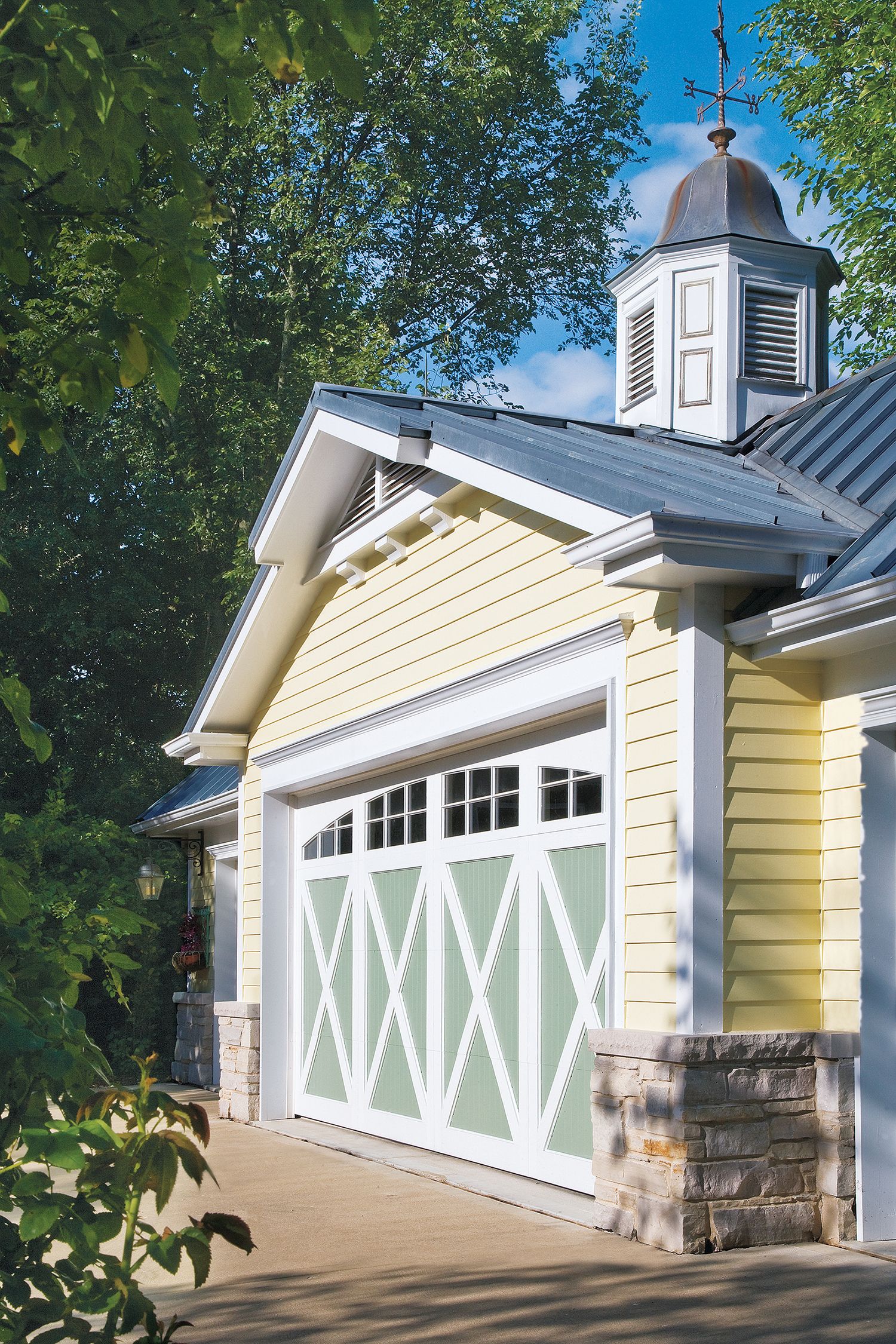The garage door is can be the focal point of the home, impacting your home’s curb appeal, energy efficiency, security, and functionality. Garage doors come in various types and materials, but the right door for your home depends on several factors. In our guide, we’ll walk you through everything you need to know about garage doors, from types and materials to maintenance and smart technology.
Anatomy of a Garage Door
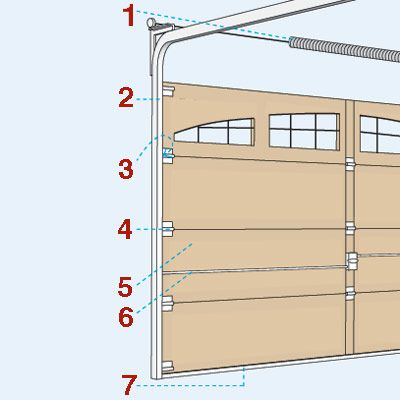
The main components of a typical sectional garage door include:
- Torsion spring: Counterbalances the door’s weight for easy lifting
- Track: Guides the door up to the ceiling and back
- Rollers: Ride inside the track—nylon rollers are quieter than steel ones
- Hinges: Connect the horizontal sections
- Sections: The individual panels that make up the door
- Lock bar: Engages with the track to prevent the door from opening
- Weatherstripping: Seals door edges against air infiltration
When you open your garage door, the torsion spring provides the necessary force to lift the door’s weight. As the door rises, the rollers guide it along the track, while the hinges allow the sections to bend and follow the curve of the track. The lock bar disengages, allowing the door to move freely. When closing, this process reverses, with the weatherstripping creating a seal when the door is fully closed.

Types of Garage Doors
There are several types of garage doors available, each with its own unique characteristics and benefits. Understanding these types can help you choose the best option for your home.
Sectional Doors
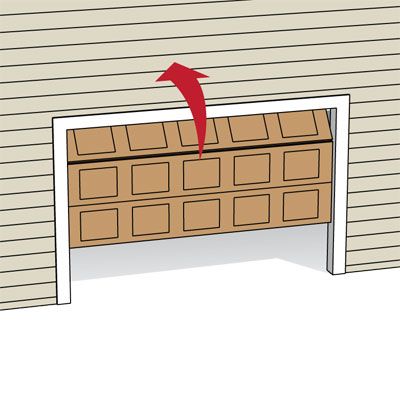
Sectional doors are the most popular type of garage door. These doors have horizontal hinged sections that roll straight up and then back along the garage ceiling. They are often assisted by a spring-balanced motorized door opener. One 3/4-horsepower opener can raise a door weighing as much as 1,000 pounds and spanning 20 feet. Built-in weatherstripping seals out the elements, making them an efficient choice for most climates.
Swing-Out Doors
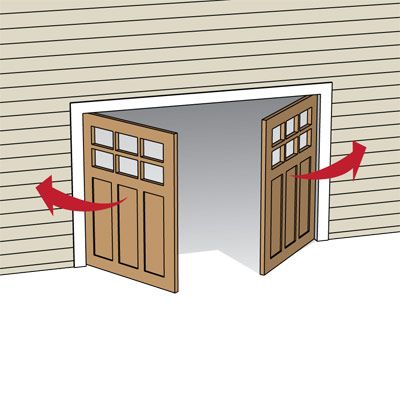
Swing-out doors consist of two doors that hang from hinges on either side of the opening. To resist sagging, each door must be well-built and at least 1 foot taller than it is wide. These doors are excellent at sealing out the weather, but they’re best suited for mild climates, as snow drifts can prevent them from opening. You can operate them manually or with a special remote control.
Sliding Doors
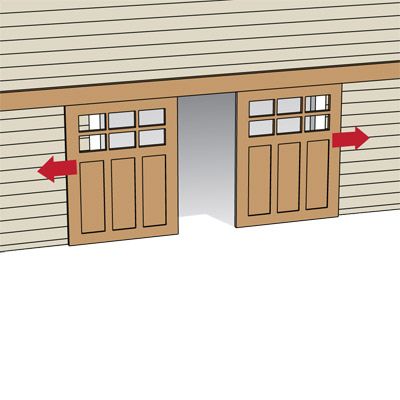
Similar to barn doors, sliding garage doors hang from rollers that ride along a track at the top of the opening. These doors are massive yet easy to operate in all kinds of weather, either manually or with a remote. The track length is about twice the door width. While versatile, sliding doors are typically the least weathertight option among garage doors.
Bifold Doors
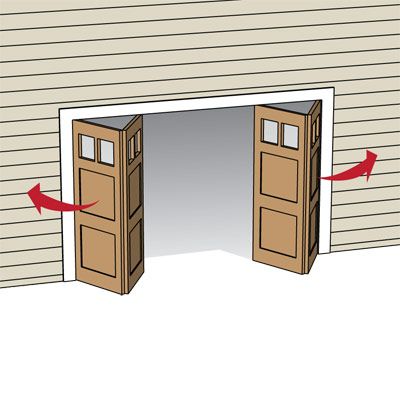
Bifold doors operate like closet doors, with pairs of hinged vertical sections that fold back against the sides of the opening. They’re not as heavy as swing-out doors and don’t open out as far, but snow buildup could prevent them from opening. Bifold doors must be manually operated, as no remote opener is available. They can’t seal as tightly as swing-out or sectional doors.
Materials Used in Garage Door Construction
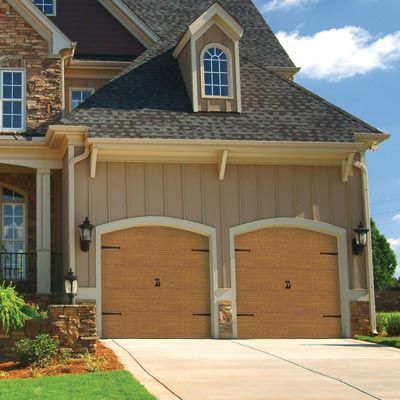
The material of your garage door affects its durability, maintenance requirements, and overall appearance. Here’s a breakdown of the most common materials used in garage door construction.
Metal
Metal doors, particularly steel, are the most popular option due to their strength, longevity, and low maintenance requirements. They come in a wide variety of designs and are available with foam insulation for improved energy efficiency. Aluminum is another metal option that’s lightweight and rust-resistant but typically more expensive than steel. According to Angi, prices for fully-installed metal doors range from $600 to $3,200.
Wood
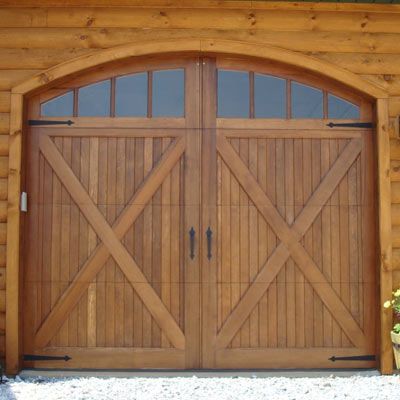
Wooden garage doors offer the widest selection of styles, shapes, and decorative add-ons. You can paint or stain to match your home’s exterior perfectly. However, wood requires the most maintenance among all materials and can be the most expensive option, with prices up to $4,500*. Regular recoating is necessary to prevent decay, especially in humid climates.
Fiberglass and Vinyl
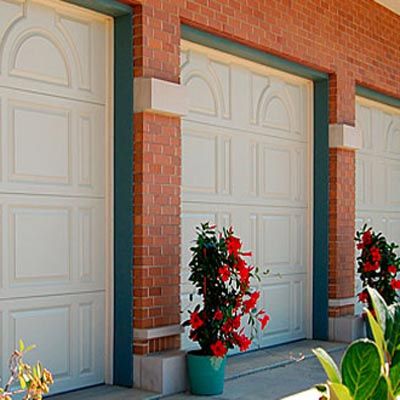
Fiberglass doors can mimic the look of painted or stained wood without the weight or maintenance requirements. Vinyl doors feature a stiff foam core that provides good insulation. Both materials are resistant to dents and rust, making them ideal for coastal areas. However, they may crack in extremely cold weather. Fiberglass and vinyl doors start at $800.
Composite
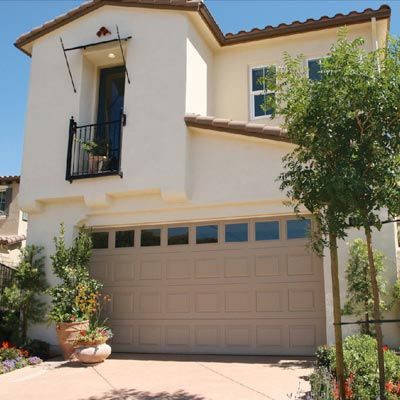
Made from cellulose fibers fused with resins, composite doors won’t crack, warp, rot, rust, or dent. Each section typically has a foam core for stiffness and insulation. This low-maintenance material is also used as trim over wood and steel doors. Prices for composite doors start at around $650.
Glass

Glass garage doors consist of panels of tempered glass or tough plastic mounted on a rustproof aluminum frame. They fill garages with natural light and can create a modern, sleek look. Options include clear, frosted, or opaque panels in single or double-pane configurations. While stylish, glass doors require heavy-duty springs due to their weight. Glass garage doors cost between $2,500 and $8,000 to install.
Garage Door Cost Considerations
Garage door costs range from $750* for basic steel and aluminum models to $4,500 or more for high-end custom wood doors. Glass garage doors are the most expensive, ranging from $2,500 to $8,000. Installation typically costs between $200 and $500, depending on the complexity of the job. Smart features and high-end openers can add to the overall cost.
While a new garage door can be a significant investment, it often provides a good return on investment (ROI). According to Remodeling Magazine’s 2024 Cost vs. Value report, garage door replacement consistently ranks as one of the top home improvement projects for ROI, recouping over 193% of the cost in increased home value. Additionally, an energy-efficient door can lead to long-term savings on heating and cooling costs.
*Cost data in this article sourced from Angi.
Garage Door Safety Features

Modern garage doors come equipped with several safety features to prevent accidents and injuries.
According to the Consumer Product Safety Commission, all garage door openers manufactured after 1993 must have two auto-reverse mechanisms, including photo eye sensors and pressure sensitivity. Photo eye sensors detect objects in the door’s path and reverse the door if something breaks the beam, while pressure sensitivity automatically reverses the door if it encounters an obstacle while closing. Test these features monthly by waving a stick through the photo eye beam and by placing a roll of paper towels in the door’s path. If either test fails, contact a professional immediately.
In case of power outages or opener malfunctions, every garage door should also have a manual release handle. This red rope hangs from the opener’s trolley and allows you to disconnect the door from the opener, enabling manual operation. Familiarize yourself with its location and operation for emergency situations.
Energy Efficiency and Garage Door Insulation
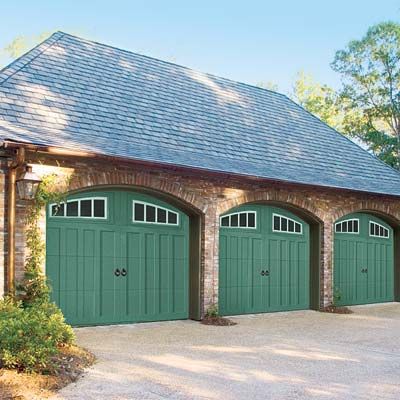
An energy-efficient garage door, especially an attached garage door, can help reduce your home’s overall energy consumption. Look for doors with high R-values, which indicate better insulation properties. R-values range from zero to 20, where zero represents a door with no insulation, and 20 represents the highest level of insulation. Insulated steel and aluminum doors can have R-values as high as 17, while wood door insulation often goes up to R-10. Consider the climate in your area when choosing insulation levels.
Smart Garage Door Technology
Smart garage door technology offers convenience and enhanced security. For example, modern garage door openers come with sophisticated remote control options. Many now feature rolling code technology, which changes the access code each time after use, preventing code theft. Some systems allow you to control your garage door via smartphone apps, enabling you to open or close your door from anywhere.
Smart garage door openers can also integrate with broader home automation systems. This integration allows you to set schedules for your garage door, receive alerts when the door opens, and link your garage door to other smart home features, such as lights or security systems.
Enhancing Your Garage Door’s Appearance
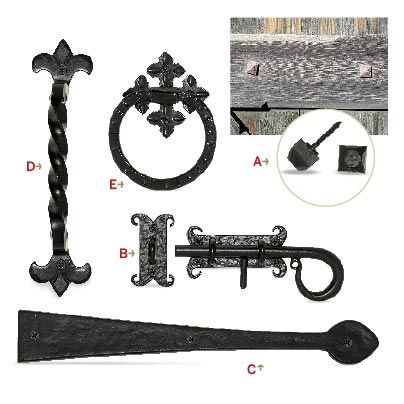
Investing in your garage door’s appearance, such as applying a fresh coat of paint or mounting new hardware, can significantly impact your home’s curb appeal. For instance, a coat of paint or a new finish can transform your garage door’s look. For the most durable finish, consider a factory-applied option. If you’re painting yourself, use acrylic latex paint for the best results on any material, including fiberglass and vinyl. For wood doors, a clear coat can highlight the natural beauty. Apply three coats of a translucent alkyd for a lasting finish.
Adding decorative hardware can also give your door a custom look. Options include:
- Handles and latches
- Decorative hinges
- Clavos (decorative nailheads)
- Window inserts
Garage Door Maintenance and Care
Regular maintenance can extend the life of your garage door and prevent costly repairs. Here are some tasks you can perform.
- Lubrication: Apply lubricant to moving parts like hinges, rollers, and springs every six months.
- Tightening: Check and tighten all nuts, bolts, and screws annually.
- Balance test: Disconnect the opener and manually lift the door. It should stay in place when half-open.
- Visual inspection: Look for signs of wear, damage, or rust monthly.
- Weatherstripping check: Ensure the weatherstripping is intact and replace if damaged.
When To Call a Professional
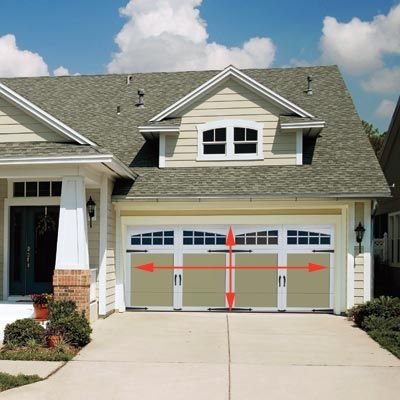
While many maintenance tasks can be DIY, some situations require professional attention:
- Spring replacement: Torsion springs are under high tension and are dangerous to replace
- Cable issues: Call an expert to fix frayed or damaged cables
- Opener malfunctions: If your opener isn’t working correctly, a professional can diagnose and fix the issue safely
- Door misalignment: If your door isn’t closing evenly, a pro can realign the tracks and rollers
- Annual inspection: Have a professional inspect your door system annually to catch potential issues early
Troubleshooting Common Garage Door Issues
Even well-maintained garage doors can experience issues. If your door isn’t closing evenly or is sticking, there may be a misalignment. Check the tracks for debris and ensure they’re properly aligned. If the problem persists, it’s best to call a professional, as misalignment can lead to more serious issues if not addressed promptly.
If your garage door is making excessive noise, it could be due to:
- Loose hardware: Tighten all nuts and bolts
- Lack of lubrication: Apply lubricant to moving parts
- Worn rollers: Replace plastic rollers with nylon ones for quieter operation
DIY vs. Professional Garage Door Installation
While some manufacturers sell directly to homeowners, garage door installation can be dangerous and is generally best left to professionals. The complex spring systems and heavy components pose significant risks to untrained individuals. For most homeowners, the safest and most efficient option is to hire a professional to install your garage door. Professional installation ensures proper setup, alignment, and safety feature activation.
Take accurate measurements before shopping for a new garage door. For sectional doors, measure the height and width of the opening to determine if you need a stock or custom size. Most stock sectional doors cover openings 7 to 8 feet high and 9 to 16 feet wide. For larger openings or non-sectional doors, it’s best to have a professional measure to ensure a perfect fit.
How To Choose the Right Garage Door for Your Home
When choosing a garage door, consider your climate, budget, maintenance preferences, and energy efficiency needs. For example, if you live in a coastal area, you might want to opt for fiberglass or vinyl to resist rust. If energy efficiency is a priority, look for insulated doors with high R-values. Also, think about the long-term maintenance requirements of different materials.
Your garage door should also match your home’s architectural style. For a Colonial-style home, consider a door with formal wall paneling or divided-light windows. Craftsman-style houses pair well with doors featuring rectilinear shapes and two-tone color schemes. For a modern home, sleek glass doors or minimalist designs work best. Our article on garage door trends can help provide some inspiration.
Style: Neo-Colonial
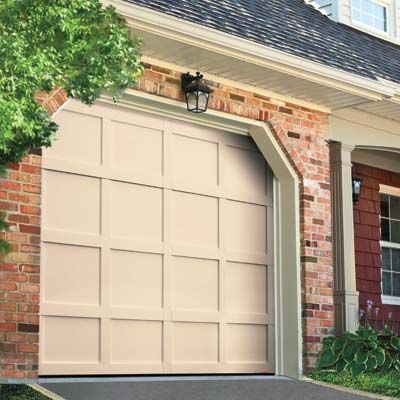
Resembling formal wall paneling, this door is in tune with the fluted columns, divided-light windows, and other Colonial elements on this newer house.
Similar to shown: Cambridge sectional insulated steel with composite overlay trim, garaga.com
Style: Traditional
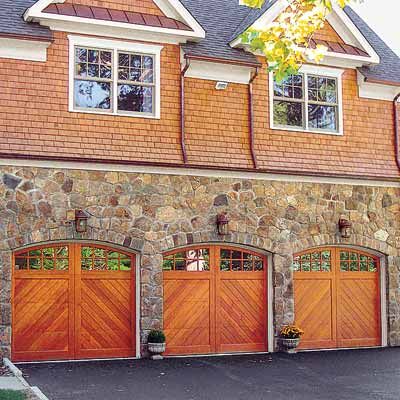
Wood arch-top doors with divided-light windows and herringbone panels have the look of a Victorian-era stable.
Similar to shown: Northwest Door Heritage Classic model C008C sectional insulated western red cedar, nwdusa.com
Style: Craftsman
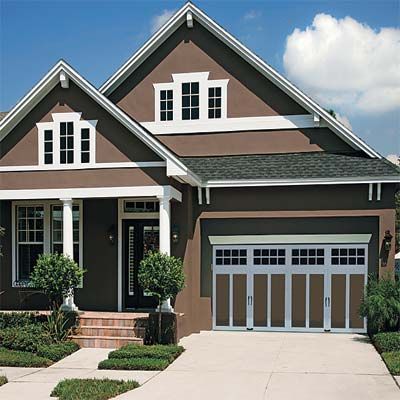
A two-tone color scheme highlights the rectilinear shapes popular in the Arts and Crafts-style architecture.
Similar to shown: Coachman Collection model CD12 sectional insulated steel with composite overlay trim, clopaydoor.com
Style: Mission
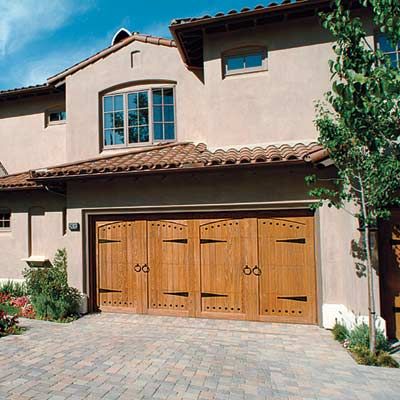
Iron strap hinges, handles, and decorative nailheads, known as clavos, evoke Spanish-Colonial style entry doors.
Similar to shown: Mediterranean Collection model 6000A sectional in alder, summitdoorinc.com
Style: Modern
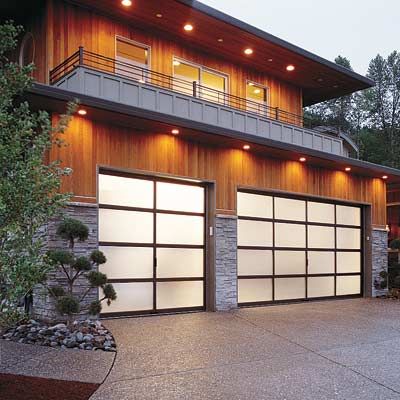
Stripped to the essentials, this translucent glass door is reminiscent of a Japanese shoji screen.
Similar to shown: Avante Collection sectional with frosted glass in a bronze, anodized-aluminum frame, clopaydoor.com
Style: Rustic

This informal style, with lots of knotty, rough-sawn wood, calls for an equally relaxed wood garage door.
Similar to shown: Carriage House Door Co. model 3020K insulated wood sectional with reclaimed barnboard, carriagedoor.com
Accessories: Pergola
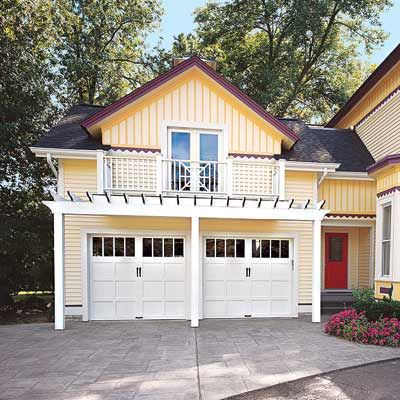
This classic structure shades the doors while providing support for a handsome garland of clambering vines, like clematis and honeysuckle.
Similar to shown: Attached pergola in cellular PVC, walpolewoodworkers.com
Accessories: Lights
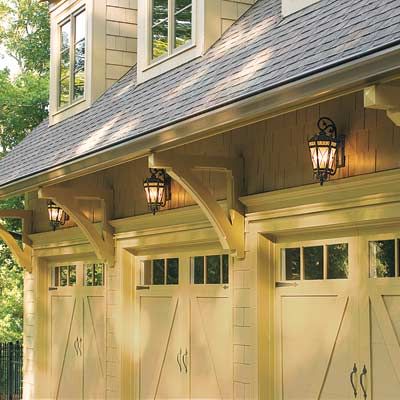
Sconces mounted above or to the side of an opening add a welcoming glow while making it easier to locate a handle or a keypad opener in the dark. For convenience, equip the lights with a motion detector so that they’ll switch on when you approach.
Similar to shown: Camelot model 1705BK cast-aluminum sconce, hinkleylighting.com
Our Conclusion
Garage doors have evolved from simple, functional barriers to key components of home design and security. With a wide range of types, materials, and features available, homeowners can find a door that not only enhances their home’s curb appeal but also provides energy efficiency and smart functionality.
When choosing a garage door, consider factors like climate, maintenance requirements, and your home’s architectural style. While you can DIY some maintenance tasks, we recommend hiring a professional for installation and major repairs.
